
ARCHIVED PAGE - PLEASE READ!
This page was written by me a long, long time ago. As such the quality of the writing, photography and/or any conclusions I may have come to simply do not stand up to the levels I consider necessary these days.
I do not believe in deleting things outright though as I feel that these pages form something of a time capsule from an earlier stage in my life, and may still be of some interest to folks who have been coming here for a long time. So instead of deleting this page it has been archived.
PLEASE NOTE THAT THIS PAGE HAS BEEN ARCHIVED, AND SHOULD BE CONSIDERED "FOR INTEREST ONLY" AND NOT BE USED FOR ANY OTHER PURPOSE. LINKS, PRICING ETC ARE LIKELY TO BE OUTDATED AND WILL NOT BE UPDATED.
Tesco 3 Watt LED Aluminium Torch. Model FT-MN-2C. Rating: 70%

Product Info:
| Manufacturer: | Tesco Stores Limited - Unknown who actually makes it for them though |
| Available from: | N/A - Obsolete product. |
| Price: | £12.00 GBP as of August 2009 |
| Size: | 175 x 40 mm |
| Number of lamps: | 1. |
| Lamp Type: | 3W Seoul Semiconductor ZLED with refractive optics. |
| Peak Beam intensity: | Not stated. |
| Total Luminous Flux: | Not Stated. |
| Lamp Current: | Not Stated - Unable to measure readily due to circuit design |
| Lamp Colour: | Cool white. |
| Body finishes available: | Black. |
| Battery type: | 2 C size - Supplied. |
| Battery life: | Not Stated. |
| Switch Type: | Click action push button on tailcap - intermittant off. |
| Water Resistance: | "Weatherproof" |
| Approximate Beam angle: | Medium flood |
| Notes: | Light is supplied with nylon belt pouch, wrist strap (fitted) and Raymax brand alkaline batteries (installed). |
| Review Date: | 23rd August 2009 |
First Impressions:
Tesco do a pretty good job of trying to make sure you don't spot this light...the light's black, the backing card's black. The only thing which really picks it out at all is the one line of orange text at the top. It's classy enough as packing goes - but doesn't do a good job of making it jump out at you compared to the other big brand lights sitting next to it on the shelf. There also wasn't a price tag on the shelf in the case of our example, requiring me to wander around the store for nearly fifteen minutes until I got hold of a member of staff who could tell me what it cost. On the back of the card, there are the usual warnings about not mixing batteries and such in a variety of languages.

This
is one of those sonic welded plastic blister packs which we all hate.
Getting into this bare-handed quite simply is not going to happen
as the plastic is really quite thick. Go find yourself a good,
sharp pair of scissors and cut carefully around the edge. Careful
that you don't cut the lanyard, the holster or of course your fingers.
Batteries:
This
light comes with the batteries already installed, however you need to
remove a little plastic disc which stops it from switching on and
running them down while in the pack before you can use it. This
resides in between the negative end of the cell nearest the tail cap and
its spring contact. To remove this disc, simply unscrew the
tail cap and pick it out. I was going to take a photograph of it,
however haven't the foggiest idea where it went when it dropped
out...and I don't think any of you are going to be heartbroken that
I've not included a photograph of a little 15mm diameter piece of clear
plastic.
It was only after I'd done this that I actually read
the instructions...such as they are...and realised that you're actually
meant to unscrew the head to change the batteries. I don't see
any reason really that there's an advantage to removing either the head
or the tail cap...either works! It's worth noting however that the
head and tail cap have to go into the correct ends of the body tube, as
the threading is longer on one end than the other.
In
fact, it's possible to dismantle this light to quite an extent, though
I'd recommend against removing the bezel from the head, as both the LED
and the optics are quite easily damaged - I've done this only to
demonstrate what's in there (and to find out what sort of LED it
was)...and of course to prove that it could be done.
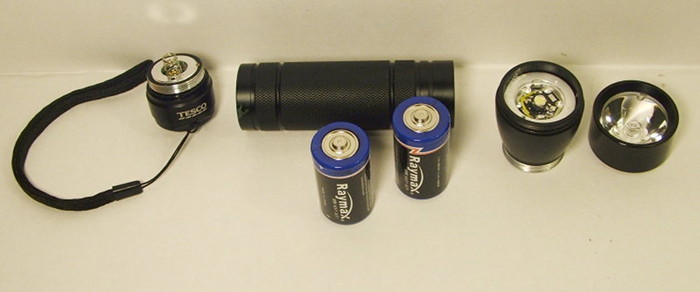
Changing
the batteries is simply a matter of unscrewing whichever end you decide
to use, then catching it when it tries to roll off the desk, dumping
out the old batteries and inserting two new C cells with the positive
end facing the head. Then screw either the head or the tail cap
back on, and you're done.
There's no mention of battery life made on the packaging, so I think some experimentation will be needed there.
It's
worth noting that the two C cells which this flashlight uses only
produce around 3 volts - nowhere near enough to light the LED. To
get around this problem without requiring additional batteries (and
hence a larger, heavier light), there is a clever little circuit built
into the head which boosts the supply voltage to the correct level to
feed the LED. The current the LED is being supplied with, the
efficiency of this boost circuit and its drop out (the minimum voltage
it needs to see from the batteries to function) will all contribute to
determine the runtime on a set of batteries for this flashlight.
The characteristics of this circuit will also determine whether
the light starts out brightly and slowly dims over a period of time, or
whether it maintains a relatively constant level of brightness for a set
time, before suddenly dropping very quickly to nothing.
At
this point, this is rather a blank slate! I'll have to do some
testing then come back! Things are looking good for the light
though in that it uses relatively cheap and readily available
batteries, and that they're easy to change. My gut feeling at
this point is that the battery life should be pretty good.
I've
noted a tendency for the batteries to rattle quite a lot in this light,
this causing a corresponding flicker sometimes. This is dead easy
to solve though - just fold up a quarter of a sheet of A4 paper and
stuff it in beside the batteries - problem solved. While this
wouldn't really be acceptable in a high end light...I think we'll
forgive this one given its price. It's more of a niggle than a
problem.
Switching on:
Lights don't come much simpler than this. No fancy multiple modes or things like that, just one button. Admittedly, said button isn't hugely obvious being smoothly integrated into the base of the flashlight, but generally people will find it within the first ten seconds of the light being handed to them - about a second later they're seeing spots because they looked into the business end when it was switched on. That's really not a good idea in the case of this flashlight, as it's really quite bright - for that reason there's no doubt that you've switched it on even if you're in a brightly lit room.

Signalling
with this light is possible, however the switch is of the "intermittent
off" type, whereby partly depressing the button when the light is on
will result in it going out until the button is released. Not
really an issue for every day use, however some people are not keen on
switches of this type, so it's worth mentioning.
There
are no lockout functions or other operating modes on this light, so
there's no need to waste time looking for them. Despite the lack
of a lockout mode, I wouldn't be too worried about the light getting
switched on in a backpack or pocket, as the button needs to be
depressed beyond the level of the metal around it and requires a
reasonably firm press. If the light is kept in its holster, this
will almost completely eliminate the possibility of accidental
activation.
Performance:
As I stated earlier, the days of LED flashlights being dim little things you could use to find change in the bottom of your wallet or save having to fumble around finding the keyhole in the back door when it's dark are long, long gone. What we've got here is a flashlight which can quite easily knock the socks off (well, if flashlights had socks anyway) of a huge number of incandescent flashlights, including many costing many times its own price.
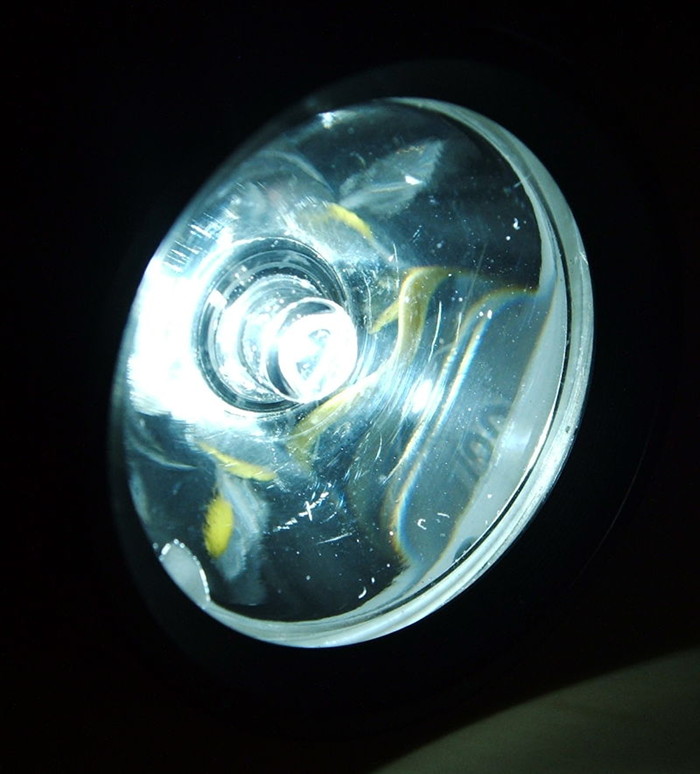
It's
bright though, make no mistake. A little 4 LED based 2AA light I
have is quite sufficiently bright for wandering around the house with,
or peering down the back of car engines to see where that screw that
you just dropped went. If I shine these two onto the wall across
the room however, I can barely even see the light from the smaller
light, it being completely drowned out by the Tesco one.
For
most every day tasks in and out the house, I can't see this light
lacking in the power stakes. Hunting for stuff in the shed or the
attic, wandering around the house in a blackout, walking to/from the
car, walking the dog, working on the car, or just leaving it sitting on
the desk and waiting for someone to pick it up and dazzle themselves -
does them all quite easily.
If
you really need more light than this produces, to be honest you're not
really going to expect to find it at this price - you're going to be
looking at high end incandescent or HID based flashlights. This
produces more than enough light for everyday usage.
Beam Profile:
The beam profile of this light is quite typical of lights using optics of this type. The beam I would consider to be either a narrow flood or a wide spot - basically tailored to give you a light that's ideal for wandering around with, giving a good flood of light so you can see where you're going, but in a narrow enough beam that you do have at least some range. I'd say that if your eyes were adapted to a low light level that the beam's usable for a good 50-60 feet, with a high level of light for around 20. Beyond that though it's really too broad to be of much use - you need a spotlight for that.
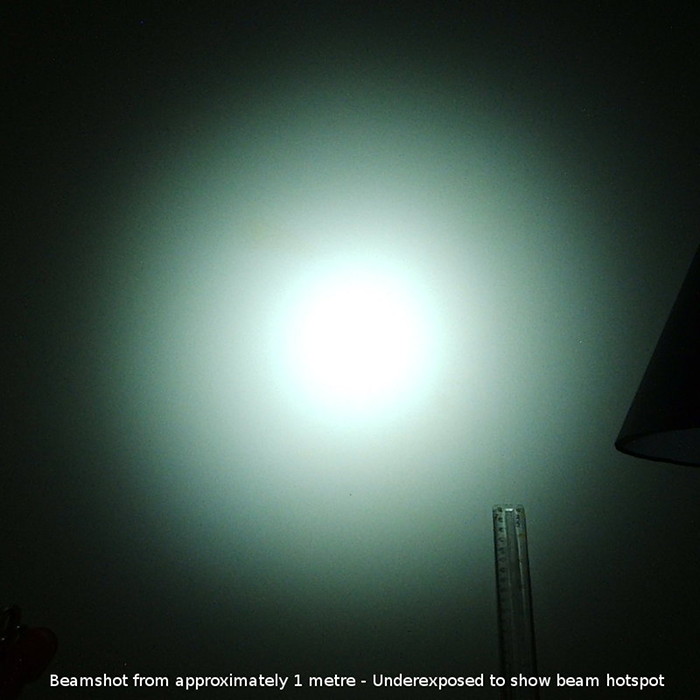
The same photograph, but filtered via the GIMP to highlight the beam details.
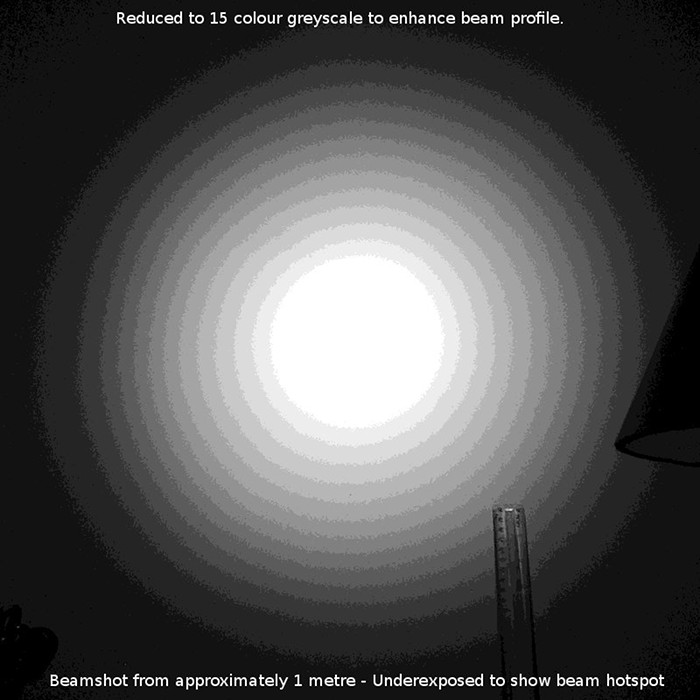
The photograph below is taken from approximately five metres (the furthest I can get from anything inside!).
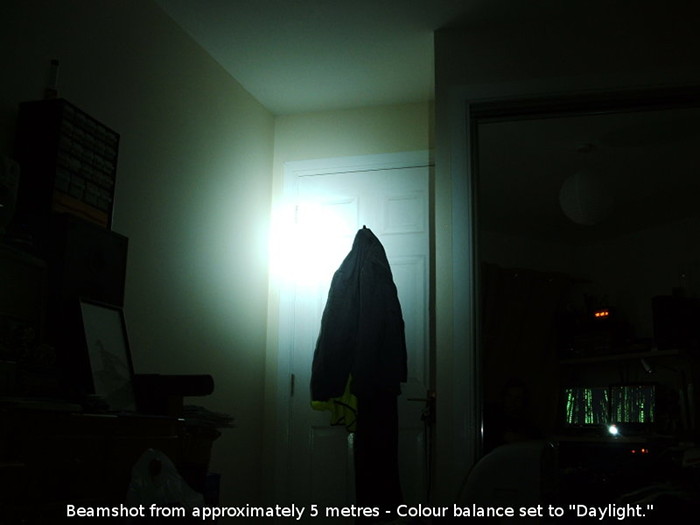
Finally,
the image below is looking out at an area of disused land to the back
of my apartment - the fifteen metre measurement is rather approximate,
but I don't think is far off.

There
is no means to adjust the beam angle of this light, it's preset by the
optics chosen by the manufacturer, so it's important that they get it
right for its intended purpose. On this occasion they seem to
have done so. The soft central hotspot is just about the ideal
size for targeting what you're looking at in a room or on the footpath
in front of you, while there's plenty of spill light so that you don't
stub your toe on the end of the bed or trip over that drain grating.
The
beam's quite a cool white, as tends to be the case with cheaper lights.
The lower colour temperature LEDs with a higher colour rendering
index being more desirable for general lighting applications, hence
attracting a higher price. For low costs lights like this, LEDs
with a less desirable tint tend to be used, this one has a fairly pure
white hotspot, with a band of warmer white in the immediate corona,
before somewhat a cooler white in the general side spill. While
some people find colour variances such as this annoying, it doesn't in
any way detract from the usefulness of the light, and I feel in such a
cheap light is quite acceptable, it's hardly noticeable after all if
you're not accustomed to looking for faults in flashlights!
People in general don't seem to mind things like this too
much...just take a look at the beam profile from a certain hugely
popular incandescent flashlight after all...compared to that this thing
produces a flawless flood of light.
Lamps:
When I saw that this was claiming to be a three watt LED light, I wasn't certain what type of LED it would be using. Thanks to a very easy to dismantle design, I was able to get into the head and track down that it's a Seoul ZLED. The precise bin of this LED (the bin code allows you to compare to a datasheet and find the electrical and optical characteristics of the LED) unfortunately I've been unable to find as this is printed on the back of the "star" board on which the LED itself is mounted, and this is very firmly attached to the heat sink.

The
LED itself cannot run directly on the 3V supplied by the batteries in
this flashlight (especially if you're using rechargeable cells which have a
slightly lower forward voltage), to provide the higher voltage of
between 3.2 and 4V needed to light the LED there is a small boost
circuit which is mounted below the LED inside a small aluminium
cylinder. This cylinder is in turn screwed into the head of the
flashlight, the two holes you see in the circular surround being used
to provide the leverage to do so. No doubt in the factory a
special tool would have been used for this - careful use of a set of
needle nose pliers was enough to get it out in the case of this light
though - be careful though as you don't want to slip and hit the LED.
It's not hard plastic like your typical 5mm LED, but is actually
a soft, silicone material and is really quite vulnerable to damage from
things like pliers, screwdrivers and soldering irons. Obviously
though most users will never be dismantling the light, so that's not a
huge issue!
All
of the light that comes out of the front of this flashlight comes from
the little yellow square you can see above. Yes...before you even
say it - I know what you're thinking "But the light is white."
You're quite correct, however there's no such thing as a high
power LED which can create white light directly. As a result of
this, LEDs such as this are actually made in two parts - there's a blue
LED at the heart of the device, this is covered with a phosphor which
glows yellow when exposed to blue light. If you mix blue and
yellow together, you'll get what is essentially white light. You
can actually see the two parts to the light in the spectra shown below.
There are two distinct parts to the image - the deep blue, this
is produced by the LED itself, and the broader section spanning the red
and yellow part of the spectra - this is the phosphor being excited by
the blue light from the LED.
Ergonomics:
This light follows a pretty well established design to be honest - wider head at one end, cylindrical barrel and a switch at the other end.

The
switch being mounted on the tail cap means that the easiest way to
operate the light one-handed is to use a "tactical" grip as shown
below, with your thumb operating the switch. This is the default
grip I tend to use when looking around a room for something, with the
light held up over my left shoulder. Just wandering around
though, just holding it like any other flashlight though it's perfectly
comfortable. Just accept that you're going to need to use your
other hand to switch it on.
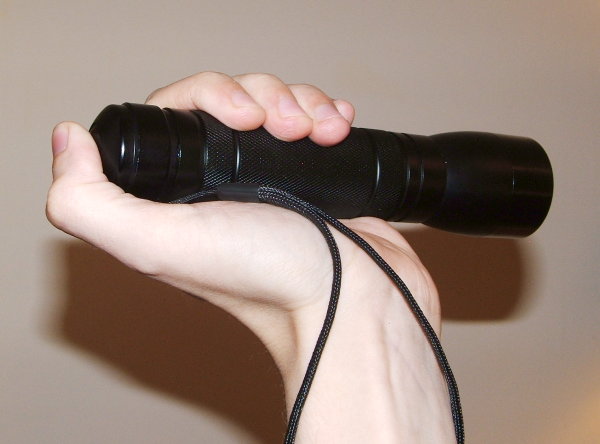
The
centre section of the body is knurled to help retention if your hands
are wet or oily, it's not very aggressive knurling, but should help you
hold onto it, without having the tendency to shred pockets and such as
can be a hazard with more aggressive machining on flashlight bodies in
some cases.
The
only real ergonomic grumble on this particular light is that there's no
form of anti-roll device whatsoever, so it tends to roll off across
whatever surface you've put it on if it's anything other than
absolutely level.
Durability Department:
While you might not expect this light to stand up to quite the same level of punishment as a $250 Surefire, I think you'll be pleasantly surprised. The walls throughout are pretty thick, the thinnest point I can find on the body itself is around the threading just below the head - and even there it's a full 1mm thick - most places nearer twice that. The thinnest bit of metal on the entire light is actually on the bezel, which is only around 0.5mm thick. The odd ding in that though isn't likely to cause any problems though. The tail cap and the button on it are both aluminium as well, the whole lot being anodized black. This is only a type 2 anodized coating however so isn't all that durable, though it'll probably fare better than most painted finishes. If you've got this light rattling around in a toolbox though it'll get scratched up pretty quick. The quality of the anodizing isn't great either - there's a little "splodge" down near the tail cap where it's not covered the body perfectly. I've photographed this blemish, it's shown below.
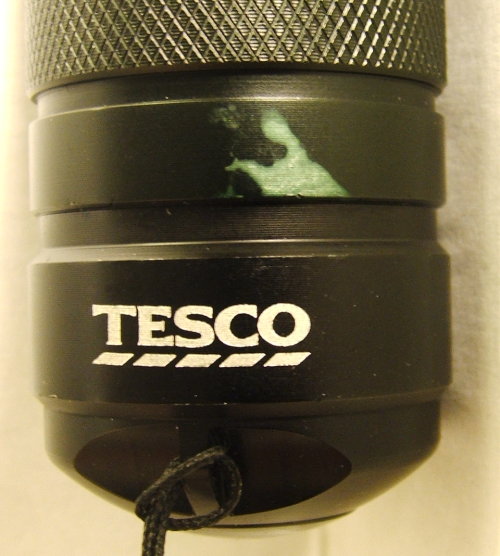
I
do have one major concern about this light - and that's the lens.
There doesn't appear to be a separate lens between the front of
the light and the refractive optic, rather that this has been used as
the lens itself. If this gets scratched up too much, that will
have an effect on the beam, and if it cracks it could well damage the
LED as well. I think the lack of a lens here, while it might have
saved a few pence on the production costs really has introduced a
significant weakness in the design. In the real world however, the
vast majority of us are unlikely to put our flashlights through enough
in their lifetimes that this will be an issue. This optic appears
to be a standard type for use with this type of LED, so should be
available from a number of sources if it does get damaged, however it's
worth noting that it'll probably cost more than the light did to buy to
replace!
There
are O-rings at all of the body joints and a suction test has showed no
leakage from either end of the light, including when the switch is
operated, so it shouldn't be bothered in the slightest by the odd
downpour when you're out walking the dog or getting dropped in a puddle
when you're out camping.
Leaving
the light at the bottom of my bathroom washbasin for a couple of hours
didn't reveal any signs of leakage whatsoever. However the light
is advertised as being weatherproof - it doesn't mention any depth
rating, so I'd advise against taking it diving with you!
The
supplied lanyard really does appear rather wimpy, and sure enough
giving it a reasonably determined tug snapped it - however that's
easily replaced with something more durable if you're likely to use it
to carry the light by it a lot. I've yet to see a cheap light of
this
sort of size which actually has a lanyard which feels up to the task!
For something to hang it from in a tent or to hang it from a hook
by the door it's more than enough.
While
the lack of a replaceable lens in front of the optics bothers me - it's
worth thinking about who this light is aimed at...it costs £12, and
it's probably going to replace that old 2D flashlight which sits in the
cupboard under the sink and gets grabbed a couple of times a year when
the power goes off, or be used now and then in the winter when you need
to venture out in the dark in the evening. Folks looking for the
ultimate in endurance flashlights are likely to be looking more towards
the high end manufacturers...not a light that's this cheap. For a
light that costs this much, and it aimed very much ar Mr & Mrs.
Average, this is plenty durable enough!
Overall:
At this price? An absolute bargain I reckon!
Pros:
+ Bright.
+ Feels great in the hand.
+ Waterproof.
+ Sensible beam pattern.
+ Uses common batteries.
+ Bargain basement price tag.
Cons:- No protective lens over LED optics.
- Supplied lanyard feels very flimsy.
Niggles:
> Batteries tend to rattle. Easily sorted with nothing more than a sheet of paper.
Ratings:
Beam Quality: 7
Build Quality: 6
Battery Life: 7
Durability: 5
Value: 10
Overall: 35/ 50 = 70%
Long Term Testing:
23rd August 2009: Review started.
5th January 2021: Page retired and moved to Site Archive.
28th April 2023: Revised Statcounter code to allow for HTTPS operation.